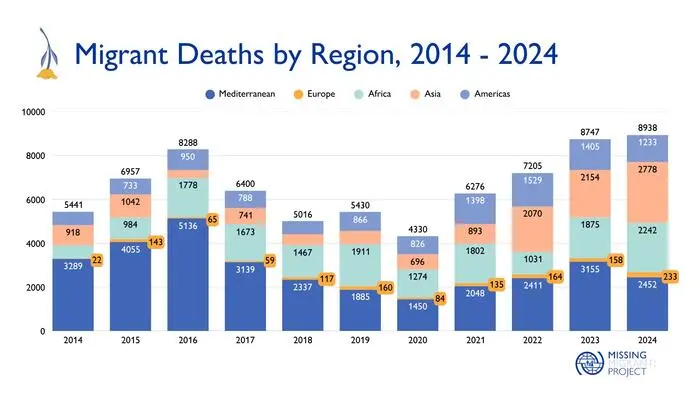New data from the International Organization for Migration (IOM) has revealed that 2024 was the deadliest year on record for migrants, with at least 8,938 deaths reported worldwide. This marks a tragic increase from 2023, when 8,747 migrant deaths were recorded, continuing a five-year trend of rising fatalities on migration routes. The IOM emphasized the urgent need for global action to prevent these avoidable losses.
IOM Deputy Director General for Operations, Ugochi Daniels, described the growing number of migrant deaths as both “unacceptable and preventable.” She stressed that behind each statistic is a human life, leaving families devastated. Daniels called for a unified, international approach to address the crisis and reduce the risks migrants face while seeking safety and better opportunities.
The data shows that 2024 was the deadliest year for migration in many regions, including Asia, where 2,778 deaths were recorded, and Africa, which saw 2,242 fatalities. Europe also recorded 233 migrant deaths. In the Mediterranean Sea, 2,452 people lost their lives, highlighting the urgent need for more search and rescue operations. Although not the highest number ever recorded in the Mediterranean, it underscores the dangers of irregular migration and the need for safer legal routes.
In the Americas, at least 1,233 migrants died in 2024, though final data is still being collected. This includes a record-breaking 341 deaths in the Caribbean and 174 fatalities among those crossing the treacherous Darién Gap, a key migration route between South and Central America. These figures reflect the extreme risks migrants face, especially in regions with harsh terrain and limited rescue resources.
Violence remains a major cause of death for people on the move. Since 2022, at least 10% of all recorded migrant deaths have been due to violent attacks. In 2024, violence was particularly deadly for migrants traveling through South and Southeast Asia, where nearly 600 people lost their lives. These figures highlight the dangerous conditions faced by those fleeing conflict, persecution, or extreme poverty.
Despite the alarming numbers, experts believe the actual death toll is much higher. Many migrant deaths go undocumented due to a lack of official reporting and the remote nature of migration routes. Additionally, most of those who die or go missing remain unidentified, leaving families in distress and without closure. The Missing Migrants Project, coordinated by IOM, aims to address these gaps by analyzing data and raising awareness of the crisis.
Julia Black, who leads the Missing Migrants Project, pointed out that beyond the rising death toll, the fact that thousands of migrants remain unidentified each year is even more tragic. Families left without answers experience immense suffering, and the lack of data makes it difficult to implement effective safety measures. She called for better tracking systems and improved policies to protect migrants.
The IOM’s upcoming annual report will provide a deeper analysis of the data on migrant deaths in 2024 and explore the issue of missing migrants during humanitarian crises. The rising death toll serves as a stark reminder of the urgent need for safe and legal migration pathways, which experts say is the only long-term solution to preventing further loss of life.

